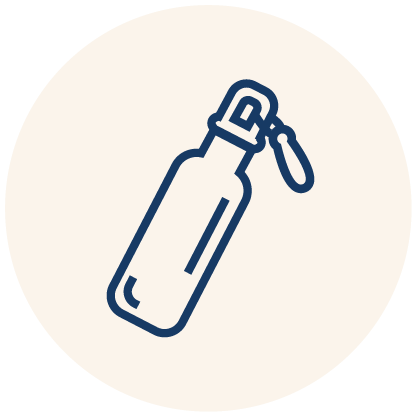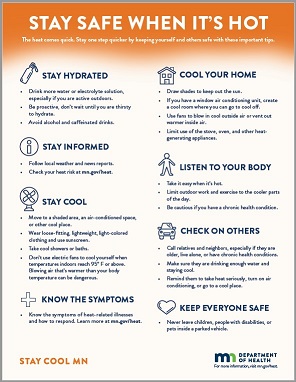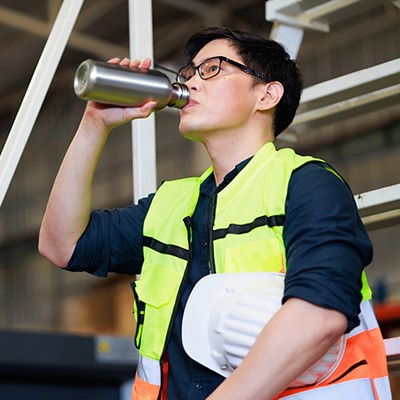The body’s ability to cool itself through sweating decreases with age, making older adults more sensitive to extreme heat. As we age, we are more likely to live with other health issues, such as chronic cardiovascular, respiratory, or kidney diseases that can worsen with heat or make heat impacts worse overall. Mobility or cognitive challenges and misuse of drugs or alcohol can also make it more difficult for some older adults to act quickly to find relief from heat. Social isolation—living alone or having few connections to people outside the household—also increases the risk of health impacts from extreme heat for adults over age 65 who do not have or use air conditioning.
Young children rely on their caregivers to keep them safe.
Children under age 5 are more sensitive to heat than adults because children:
- Absorb heat more readily than adults.
- Have a higher metabolic rate, meaning their bodies produce more heat than those of adults.
- Are less likely to notice when they are thirsty and overheating.
- May be unable to communicate their needs.
Underlying health conditions, mobility limitations, and certain medications that impair the body’s ability to regulate temperature increase a person’s risk of heat-related illness. Limited access to cooling centers, and transportation also contribute to increased vulnerability for people with disabilities during days of extreme heat.
People who work outdoors, such as farmers and construction workers, are at increased risk for heat-related illness because they are out in the heat for long periods of time, and the body produces its own heat during physical labor. Working in the heat reduces productivity, makes it harder to focus and perform skilled tasks, and increases the risk of accidents and injury. It is important for outdoor workers to take rest breaks to cool down and stay hydrated. Protective equipment and clothing that are not breathable can prevent sweat from evaporating, increasing the risk of overheating while working outdoors.
Playing sports and exercising outdoors can similarly increase the risk of heat-related illness because the body is generating heat. Even healthy, athletic people can have serious and life-threatening effects from heat stress. Avoiding activity during the hottest part of the day, taking rest breaks to cool down, staying hydrated, and wearing clothing that allows heat loss are important ways to reduce the risk of heat-related health issues.
Any health condition that affects the body’s ability to cool itself may make a person more sensitive to extreme heat. Health conditions that are known to increase risk of heat-related illness and even death during extreme heat events include:
- Cardiovascular disease
- Extreme heat puts extra strain on the heart, and people with preexisting heart conditions are at greater risk of heart attack and stroke during a heat event. Even high blood pressure may make people more sensitive to heat-related illness. Plus, some medications used to treat heart conditions can impact the body’s ability to cool itself and stay hydrated, making people taking those medications more sensitive to heat.
- Respiratory diseases
- Extreme heat increases the need for oxygen, and air pollution often worsens during extreme heat events. These conditions can exacerbate respiratory illnesses such as asthma, chronic obstructive pulmonary disease (COPD), and bronchitis.
- Kidney disease
- Kidney disease can increase the risk of dehydration and reduce the body’s ability to cool itself, increasing the risk of heat-related illness and death for people with these conditions.
- Mental illness
- Extreme heat can worsen conditions such as anxiety, depression, bipolar disorder, aggressive behavior, and risk of suicide. Some medications used to treat these conditions can also impact the body’s ability to cool itself and make people taking those medications more sensitive to heat.
- For more information on medications that may increase health risks from extreme heat, see Heat and Medications Guidance for Clinicians, U.S. Centers for Disease Control and Prevention (CDC).
During pregnancy, the heart and circulatory system must work harder to support the growing fetus, and this makes the pregnant body less able to regulate temperature and manage hydration. This makes pregnant people much more sensitive to extreme heat and at risk of heat-related illness, as well as pregnancy complications such as gestational hypertension, preeclampsia, gestational diabetes, miscarriage and preterm birth. Extreme heat can also harm the developing fetus and increases risk of low birth weight, birth defects, and stillbirth.
During extreme heat events, access to cool spaces is essential. Those without home air conditioning face greater health risks, especially residents of hotter upper floors in multi-story buildings or substandard housing with poor insulation. Unhoused individuals are particularly vulnerable to heat-related illnesses and death.







